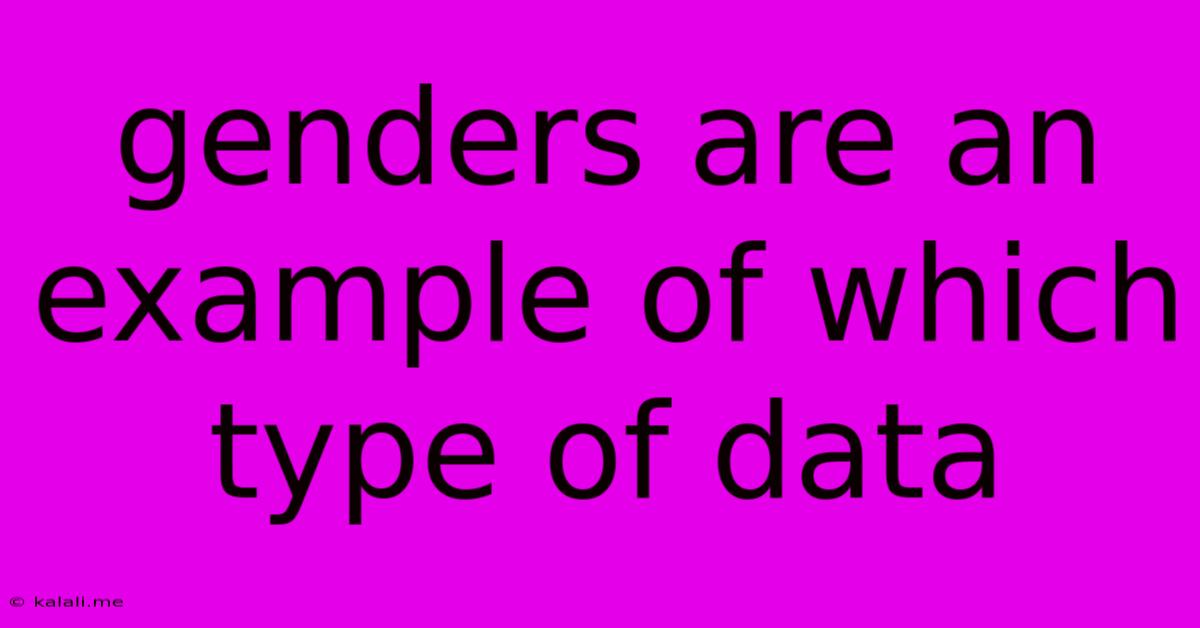Genders Are An Example Of Which Type Of Data
Kalali
Jun 14, 2025 · 3 min read

Table of Contents
Genders: Categorical Data and Beyond
Gender is a fascinating topic, and understanding how it's classified in data analysis is crucial for researchers, data scientists, and anyone working with demographic information. This article explores the type of data gender represents, discussing its nuances and implications for analysis. We'll delve into why simple categorization isn't always sufficient and explore the complexities surrounding gender identity in data collection and representation.
What Type of Data is Gender?
At its most basic level, gender is considered categorical data. Categorical data represents characteristics or qualities that can be divided into distinct groups or categories. Unlike numerical data which can be measured quantitatively (e.g., height, weight), categorical data is qualitative. In the case of gender, the categories are typically male, female, and sometimes other options like non-binary, transgender, or intersex. These categories are distinct and don't have an inherent numerical order or ranking.
Nominal vs. Ordinal Data: A Deeper Dive
Within categorical data, we find further subdivisions. Gender, in its simplest representation (male/female), is often classified as nominal data. Nominal data simply names categories without implying any order or ranking. There's no inherent value judgment in assigning someone to the "male" or "female" category; they are simply different.
However, the picture becomes more complex when we consider other gender identities. If you include categories beyond male and female (e.g., including "other" or specific gender identities), it remains nominal unless you attempt to impose an order. While tempting for simplification, this would be inappropriate and inaccurate. For instance, ranking genders would be inaccurate and ethically problematic.
Therefore, while gender is fundamentally nominal, the way it's represented in data collection critically affects its nature and subsequent analysis.
Beyond Simple Categorization: The Importance of Inclusivity
The simple male/female binary is increasingly recognized as insufficient to capture the richness and diversity of gender identity. Many individuals identify outside the traditional binary framework. Modern data collection methods must acknowledge this and incorporate options that are inclusive and respectful of diverse gender identities. This requires careful consideration of the terminology used and the option for individuals to self-identify and define their own gender.
The choice of categories directly impacts the quality and interpretation of data analysis. An overly simplified approach can lead to misrepresentation, bias, and inaccurate conclusions.
Challenges in Data Analysis
Working with gender data presents unique challenges:
- Data Collection: Ensuring accurate and inclusive data collection methods is paramount. Providing sufficient options and enabling self-identification is essential.
- Data Interpretation: Analyzing gender data requires sensitivity and awareness of societal biases and stereotypes. Simple frequency counts might not reveal the complexities of gender representation.
- Data Visualization: Choosing appropriate visualization techniques is crucial to accurately represent the diversity of gender identities without perpetuating biases.
Conclusion
In conclusion, while gender is fundamentally categorical and nominal data at its core, its representation demands careful consideration. Moving beyond a simplistic binary classification towards a more inclusive and nuanced approach is vital for accurate data analysis and a more comprehensive understanding of gender diversity. The evolving nature of gender identity underscores the need for flexible and adaptive data collection and analysis methods.
Latest Posts
Latest Posts
-
What Is The Multiple Of 12
Jun 14, 2025
-
What Is The Difference Between Geology And Geography
Jun 14, 2025
-
Verbs That Start With The Letter E
Jun 14, 2025
-
Lcm Of 8 9 And 6
Jun 14, 2025
-
Which Of The Following Is Not A Copd
Jun 14, 2025
Related Post
Thank you for visiting our website which covers about Genders Are An Example Of Which Type Of Data . We hope the information provided has been useful to you. Feel free to contact us if you have any questions or need further assistance. See you next time and don't miss to bookmark.